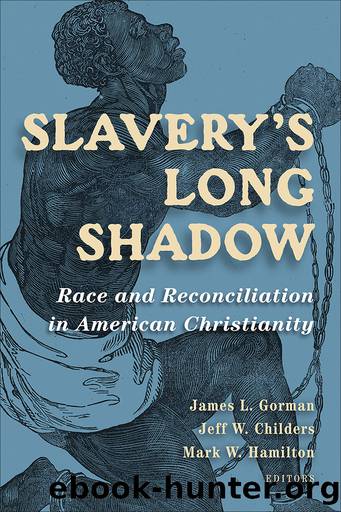Slavery's Long Shadow by Gorman James L.;Childers Jeff W.;Hamilton Mark W.;

Author:Gorman, James L.;Childers, Jeff W.;Hamilton, Mark W.;
Language: eng
Format: epub
Publisher: Wm. B. Eerdmans Publishing Co.
1. Catherine A. Brekus, The Religious History of American Women: Reimagining the Past (Chapel Hill: University of North Carolina Press, 2007), 1.
2. For more information on the Stone-Campbell Movement, see D. Newell Williams, Douglas A. Foster, and Paul Blowers, The Stone-Campbell Movement: A Global History (Saint Louis: Chalice, 2013). For more information on race relations in the Stone-Campbell Movement, see Wes Crawford, Shattering the Illusion: How African American Churches of Christ Moved from Segregation to Independence (Abilene, TX: Abilene Christian University Press, 2013); Barclay Key, âRace and Restoration: Churches of Christ and the African American Freedom Struggleâ (MA thesis, University of Florida, 2007); Brenda M. Cardwell and William K. Fox, Journey toward Wholeness: A History of Black Disciples of Christ in the Mission of the Christian Church ([Nashville]: National Convocation of the Christian Church [Disciples of Christ], 1990); Carroll Pitts Jr., âA Critical Study of Civil Rights Practices, Attitudes and Responsibilities in Churches of Christâ (MA thesis, Pepperdine University, 1969).
3. See Douglas A. Foster, âUnity, Christian,â in The Encyclopedia of the Stone-Campbell Movement, ed. Douglas A. Foster et al. (Grand Rapids: Eerdmans, 2004), 754â58.
4. See Williams, Foster, and Blowers, The Stone-Campbell Movement, 44â45.
5. Winfred Ernest Garrison and A. T. DeGroot, The Disciples of Christ: A History (Saint Louis: Christian Board of Publication, 1948), 468.
6. For women in the Stone-Campbell Movement, see Loretta M. Long, âChristian Church/Disciples of Christ Tradition and Women,â in Encyclopedia of Women and Religion in North America, ed. Rosemary Skinner Keller, Rosemary Radford Ruether, and Marie Cantlon (Bloomington: Indiana University Press, 2006), 1:296â307; Loretta M. Long, The Life of Selina Campbell: A Fellow Soldier in the Cause of Restoration (Tuscaloosa: University of Alabama Press, 2001); Williams, Foster, and Blowers, The Stone-Campbell Movement, 61â75; Debra B. Hull, Kathy J. Pulley, and Eleanor A. Daniel, âWomen in Ministry,â in Foster et al., Encyclopedia of the Stone-Campbell Movement, 776â81.
7. For an analysis of interracial Protestant churches in the South during slavery, see John B. Boles, Masters and Slaves in the House of the Lord: Race and Religion in the American South, 1740â1870 (Lexington: University Press of Kentucky, 2015). For details on interracial churches in the Stone-Campbell Movement, see R. H. Peoples, The Historical Development of Negro Work and Its Relation to the Organized Brotherhood Life, as quoted in R. L. Jordan, Two Races in One Fellowship (Detroit: United Christian Church, 1944), 26.
8. See Elizabeth J. Clapp and Julie Roy Jeffrey, Women, Dissent, and Anti-Slavery in Britain and America, 1790â1865 (Oxford: Oxford University Press, 2011).
9. Minute Book of the Christian Church in Strasburg at the Walnut Spring School House, as quoted in Robert O. Fife, Teeth on Edge (Grand Rapids: Baker, 1971), 56.
10. Displaying proportions typical of many early churches, the minutes of the Roberson Fork Church of Christ in Lynnville, Tennessee, in the 1830s and 1840s list ten male black members and sixteen black females. See Minutes of the Roberson Fork Church of Christ (Giles County, Tennessee), 1838â1842, Tennessee State Library and Archives, Nashville. Another, smaller example is the First
Download
This site does not store any files on its server. We only index and link to content provided by other sites. Please contact the content providers to delete copyright contents if any and email us, we'll remove relevant links or contents immediately.
The Evidence of Things Not Seen by James Baldwin(247)
A Cultural History of Work in the Age of Empire by Victoria E. Thompson (ed.)(247)
Warrior Queens & Quiet Revolutionaries by Kate Mosse(245)
Executive Order No. 9066: The Terrible Injustice Of 1942 by Sollace Freeman(233)
The Explorers by Amanda Bellows(221)
A Wider Type of Freedom: How Struggles for Racial Justice Liberate Everyone by Daniel Martinez HoSang(198)
Respectability and Reform by Tara M. McCarthy(185)
Liberty's Dawn: A People's History of the Industrial Revolution by Emma Griffin(173)
The Grey Eagles of Chippewa Falls by John E. Kinville(166)
Rethinking White Societies in Southern Africa by Duncan Money(164)
Letters From London by Julian Barnes(162)
The Crosswinds of Freedom by James MacGregor Burns(160)
A Troublemaker May Surprise (The Troublemaker Series Book 2) by Genta Sebastian(149)
Evolution of Slavery Through the Ages: A Comprehensive World History of Slavery by PRESS VERITY(145)
A Teacher's Guide to Ladies of Liberty by Cokie Roberts Amy Jurskis(137)
Continental Strangers by Gemunden Gerd;(136)
The Slave Ship, Memory and the Origin of Modernity by Martyn Hudson(133)
Hunger Dark Pen by Dark Pen(126)
Beware the Masher by Kerry Segrave(124)
